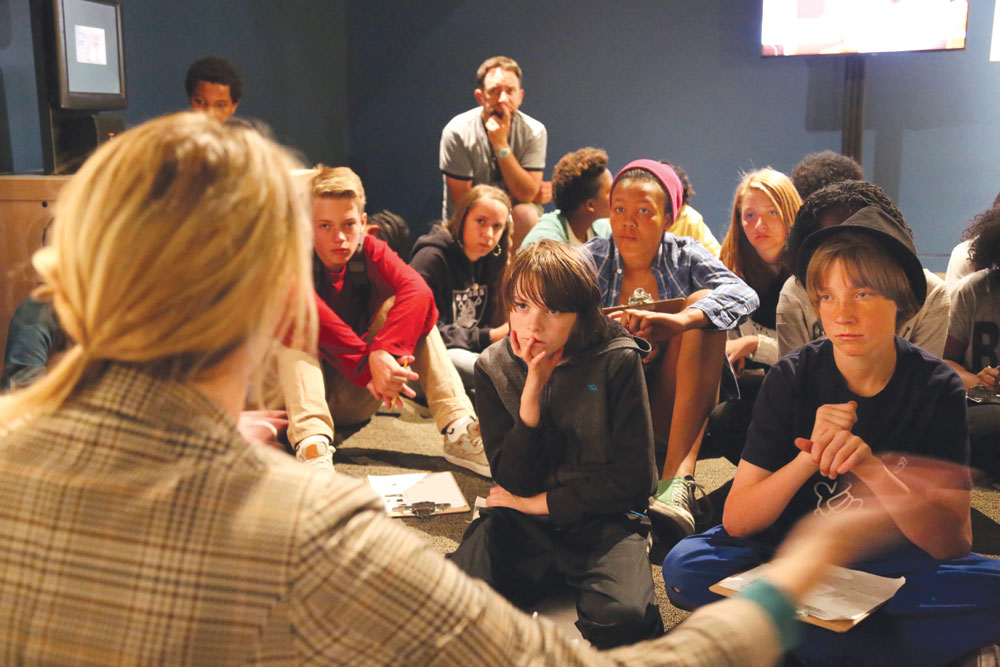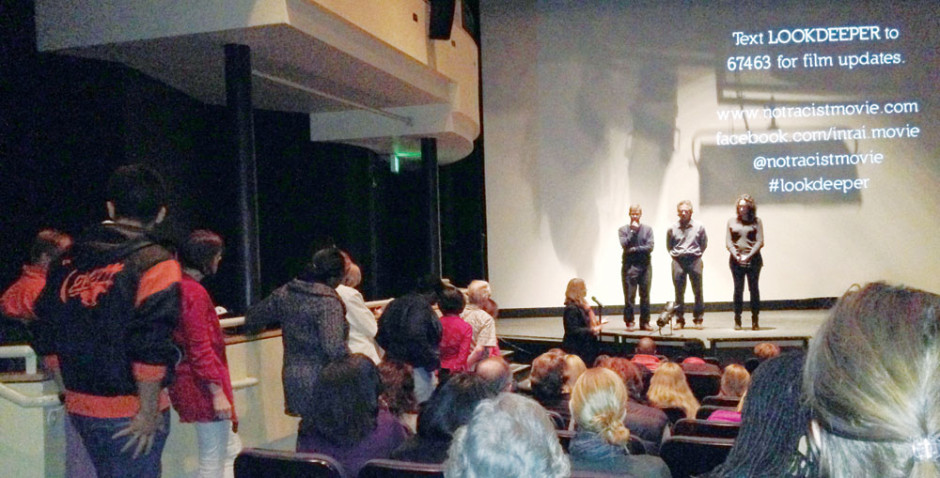
Middle school students from the Odyssey School participate in a discussion about race after visiting the History Colorado Museum exhibit “Race: Are We so Different?”

Shown above are three of the New York City teenagers (top to bottom Martha, Anna and Kahleek) who participated in a one-year project on racism that was the basis for the documentary, “I’m not a racist, am I?” Bonus footage from the film I’m Not a Racist, Am I? www.notracistmovie.com. (Photo courtesy of notaracistmovie.com)
A grid showing a widely varied selection of faces appears on the screen. At the History Colorado Center’s “How to Talk to Your Kids About Race” Workshop, participants choose a face from the grid and respond to a series of “yes” or “no” questions from their partner, who is trying to guess the chosen face.
When that activity ends, the workshop’s facilitator, Dr. Dena Samuels, asks the participants if they had inquired about the race of the person in the photograph. Out of 57 participants at the Nov. 1 workshop, no more than five hands go up. Samuels, director of the Matrix Center for the Advancement of Social Equity and Inclusion, asks the group: why? Why were they so reluctant to mention race? The responses range from the fact that talking about race is uncomfortable to the confession that people fear talking about race might actually make them seem racist.
DPS recently invited the community to attend a showing of the documentary I’m Not Racist… Am I? and participate in their “Conversations on Race.” DPS Superintendent Tom Boasberg, in his invitation to the event wrote, “We need to take the fear out of discussing race,” and that this fear must be overcome “in order to have the conversations our kids need us to be having to provide the most equitable education for every one of them.” The film, which was shown at Denver School of the Arts on Oct. 28, was also shown throughout Denver.
As recent events like the DPS-sponsored “Conversations on Race,” the History Colorado Center exhibit, Race: Are We So Different? and the accompanying workshop, “How to Talk to Your Kids About Race” suggest, organizations across Denver are confronting fears and fostering substantive discussions about race.
Conversations on Race
Students, teachers, community members, school board representatives and DPS administrators—over 150 people—gathered in the Denver School of the Arts’ auditorium on Oct. 28 for the final showing of the documentary, I’m Not Racist… Am I? The film’s director and George Washington High School alumna, Catherine Wiggington Greene, greeted the crowd and remarked with pride that this was her 10th screening of the film in Denver in 10 days.
I’m Not Racist… Am I? is part of the larger Deconstructing Race project, spearheaded by New York City’s Calhoun School, an independent and progressive pre-K–12 institution. The Deconstructing Race project seeks to “create a multimedia platform to get young people, their teachers and their families talking—and doing something—about structural and systemic racism.” Greene’s film, in particular, explores the question of “how the next generation will confront racism.” It brings a dozen New York City teenagers from a variety of racial, socioeconomic and gendered backgrounds together to document their experiences in workshops, retreats and mediated conversations over the course of one year. During this time, the teenagers grapple with difficult topics like the dangerous stereotypes embedded in the n-word, white privilege, individual bigotry and systemic racism. The project required the participants to engage their families in discussions about race, as well; so the documentary also includes intergenerational conversations about these issues. The interactions are tense, sometimes painful. The conversations are imperfect, at times humorous, and at other points blatantly offensive (www.notracistmovie.com).
For a few of the teens in the film, moreover, the experience was transformative. Sacha, for example, hails from New York City’s affluent Upper West Side and began by espousing a firm belief in the American meritocracy—the assumption that if people just work hard enough they can succeed. Over the course of the year, however, the film shows Sacha learning more about systemic forms of oppression and interrogating not only his previously held beliefs, but also his colloquial use of the n-word.
By the film’s end, there were more than a few tear-stained cheeks among the audience gathered at DSA. The director asked those in attendance to share one-word responses to the film. The words poured into the emotionally charged room: hopeful, disappointed, angry, challenged, unfinished, bold, annoyed, privileged, vindicated and frustrated were but a few.

Attendees line up to comment after the DPS-sponsored showing of “I’m not a racist, am?” Photo by Maegan Parker Brooks
This icebreaking exercise was followed by an invitation to share particular responses to the film with the group. A microphone was set up in the corner of the room and a dozen people soon lined the aisle. The audience’s responses varied widely but many linked issues from the film to their own racial experiences in Denver, both in DPS and the greater community.
One Manual graduate, now a student at Regis University, said the part of the film that featured racial profiling made her think of her African American male friends who are “routinely stopped by police in Park Hill.” She characterized this all-too-common discriminatory practice as “dehumanizing, humiliating,” and told the audience “it leaves its victims feeling like less of a person.” She also shared her experience as “a black student in DPS.” She remarked that she often “sold herself short”; that she “didn’t even consider attending DSA” because she “didn’t think she was smart enough.” And she implored the students of color in the audience not to make the same mistake: “you’re as smart as you want to be,” she told them; “you can do it, if you work hard,” she insisted to roaring applause.
Nearly two dozen community members spoke during the hour and a half discussion after the documentary. Some sincerely thanked DPS for sponsoring such an event and others staunchly criticized the district for its achievement and opportunity gaps, as well as for its inability to attract and retain faculty of color.
Boasberg; Bill de la Cruz, director of Equity and Inclusion for DPS; and the film’s director all stood on the stage and listened as the community responded. At the end of the evening, de la Cruz admitted how “hard” it was to “hear that we’re failing each other.” But he encouraged those in attendance to “let [the pain] move you, let it drive you to do something different.” He advocated an “organizational approach to solving these community issues—stop blaming, shaming and judging,” and said, “Let’s move beyond talking to acknowledging how our biases affect how we treat each other.”
Race: Are We So Different?
The History Colorado Center shares de la Cruz’s community-based organizational approach to engaging race and confronting racism. It gathered over 50 community partners, including the AARP, The Denver Foundation, and Facing History and Ourselves to bring “the first exhibition that tells the stories of race from the biological, cultural and historical point of view” to Denver. This traveling exhibit, developed by the American Anthropological Association and the Science Museum of Minnesota, is running now through Jan. 4. Museumgoers are lead through the Race exhibit by broad questions posted around the room: Why talk about race? What is race? What’s race got to do with health, school and housing? How do you experience race? And what accounts for different skin color? There are images, detailed explanations and interactive quizzes, in addition to videos playing, which feature leading scholars responding to the exhibit’s core questions. The exhibit also invites participants to share their story on notecards that then become part of the display. What’s more, Race enlists patrons to photograph their skin color, an image of which gets projected among a variety of hues captured by previous participants (http://historycoloradocenter.org/exhibits/race/).
How to Talk to Your Kids About Race
In connection with the Race exhibit, the History Colorado Center is offering a series of workshops to help all parents, and parents of adopted children, in particular, talk with their children about race. The two-hour workshops include a tour of the Race exhibit and conclude with a discussion led by Samuels. The sociologist provides several suggestions to parents, including: making time to start the conversation, acknowledging why the topic makes us uncomfortable, and being “hard on the problem, but soft on the person.” Samuels suggests, “The answer is not colorblindness. The answer really is talking more about this stuff.”
Continuing the Conversation
The History Colorado Center and DPS plan to keep the conversation going. From 1-3pm on Dec. 6, History Colorado will offer another workshop on “How to Talk to Your Kids About Race.” After the Race exhibit leaves Denver in January, the center will continue with the second half of its six-month program, FWD: Race. This lecture series features upcoming discussions about Chicano Identity and Social Movements of the 1960s and Early ’70s (www.historycolorado.org/adult-visitors/fwd-history-and-science-race-0).
DPS characterizes conversations about race as inextricably woven into the district’s fundamental vision of Every Child Succeeds. “As we work together toward our vision,” Boasberg wrote to the community, “we must acknowledge how race impacts our students and how we can address those challenges and biases we have in our society and even in ourselves.”
Below: Bonus footage from the film I’m Not Racist… Am I? www.notracistmovie.com




0 Comments